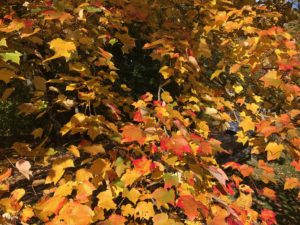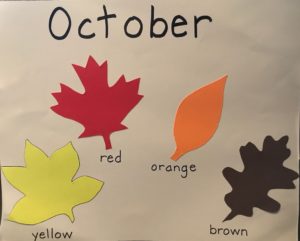 Here’s a series of fall arts activities that include movement, music, art and poetry. These activities are perfect for arts integration into curriculum, offering children a chance to reflect on fall colors and the change of seasons, as well as botany and earth science related to seasonal change. These lessons are great for children in grades pre-K through 2, and can be modified depending on age of the students.
Here’s a series of fall arts activities that include movement, music, art and poetry. These activities are perfect for arts integration into curriculum, offering children a chance to reflect on fall colors and the change of seasons, as well as botany and earth science related to seasonal change. These lessons are great for children in grades pre-K through 2, and can be modified depending on age of the students.
I start the activities with music and movement. Children can use autumn colored scarves as they move to these songs in ¾ time. Here are two songs I have used.
Autumn Leaves are A-Falling
Hear tune here. Lyrics from KIDiddles, Terri Klutmans, 1999
Autumn leaves are a-falling;
Red and yellow and brown;
Autumn leaves are a-falling,
See them fluttering down.
Tra, la, la, la, la, la, la,
Tra, la, la, la, la, la,
Autumn leaves are a-falling,
See them fluttering down.
Arms and hands above head, moving
around as if they were fluttering leaves.
Autumn leaves from the treetops
Flutter down to the ground,
When the wind blows its trumpet,
See them whirling around.
Tra, la, la, la, la, la, la,
Tra, la, la, la, la, la,
When the wind blows its trumpet,
See them whirling around.
Hands start out over head,
then flutter down to the floor.
Autumn leaves when they’re tired,
Settle down in a heap,
At the foot of the old tree,
Soon they’ll all fall asleep.
Tra, la, la, la, la, la, la,
Tra, la, la, la, la, la,
At the foot of the old tree,
Soon they’ll all fall asleep.
Children sink softly to floor,
and pretend to fall asleep.
October
Liz Buchanan
October, October, leaves orange, green, red, yellow, brown.
October, October, leaves falling down, down to the ground.
(Spoken) Now a big gust of wind! Woosh! (Faster tempo) Leaves fall down to the ground!
 With a gently swaying tempo, children stand and hold their hands up, pretending to be trees with leaves high in the air, swaying in the wind. Bring hands down slowly to the ground as you stoop on “falling down, down to the ground.” Oh “woosh,” move back to standing position and brush hands up high, then bring hands quickly back down to the ground.
With a gently swaying tempo, children stand and hold their hands up, pretending to be trees with leaves high in the air, swaying in the wind. Bring hands down slowly to the ground as you stoop on “falling down, down to the ground.” Oh “woosh,” move back to standing position and brush hands up high, then bring hands quickly back down to the ground.
Hear the tune here. You can also sing other fall and leaf-related songs.
After movement activities, the children can be asked to reflect on how they moved as autumn leaves. They might mention swaying in the wind, floating down, blowing harder with the wind, or even leaves crunching under one’s feet. One purpose of this reflection is to build vocabulary related to autumn leaves and movement. I also might take this opportunity to build vocabulary related to the colors of the leaves, adding color words that children might not know, such as crimson, amber, and vermillion – or discussing things that have similar colors to the leaves: fire, sun, lemon, apple.
A related activity is leaf rubbing, creating pictures of a variety of leaves in fall colors. Leaf rubbing is a simple activity that gives children a chance to touch and smell leaves, as well as looking more closely at the structure of a leaf and considering the shapes of leaves that come from different types of trees. Gather leaves from outside then put them under a sheet of paper and rub a crayon on top. Watch the leaf shape emerge! You can listen to the “fall” section of Vivaldi’s Four Seasons while creating art. Later, if you’re able to take a walk, gather leaves and identify trees, so much the better. You can also read books such as Lois Ehlert’s Leaf Man.
The next part of this series of fall arts activities is poetry writing. Choose a simple poetry form, such as the cinquain.
A cinquain has the following form:
Line A: One vague or general one-word subject or topic
Line B: Two vivid adjectives that describe the topic
Line C: Three interesting -ing action verbs that fit the topic
Line D: Four-word phrase that captures feeling about the topic
Line E: A very specific term that explains Line A
Here’s an example:
Fall trees
Crimson, amber
Glowing, swaying, changing
Awaiting the chilly wind
Blazing maple
You could also consider haiku or acrostic forms. Haiku, a form from Japan, has three lines: 5 syllables in line 1, 7 syllables in line 2, 5 syllables in line 3. Acrostic uses a word down the left-hand column to form the starting letters of each line. Here’s an example:
Swirling flakes, icy against my face
Night wind blowing, clouds lighting the sky
Over rooftops, over trees, a blanket falls
White over all.
I have done this series of lessons with kindergarten students, many of whom were pre-readers. Writing cinquain poems, I helped each student consider what each line of the poem should be. Some students chose colors and phrases from a class-compiled list that I read back to them. We took the students’ poems and posted them among the leaf-rubbing pictures.
As a final activity, you could read the poems aloud or even set them to music.





Wonderful! Thank you for sharing these ideas.